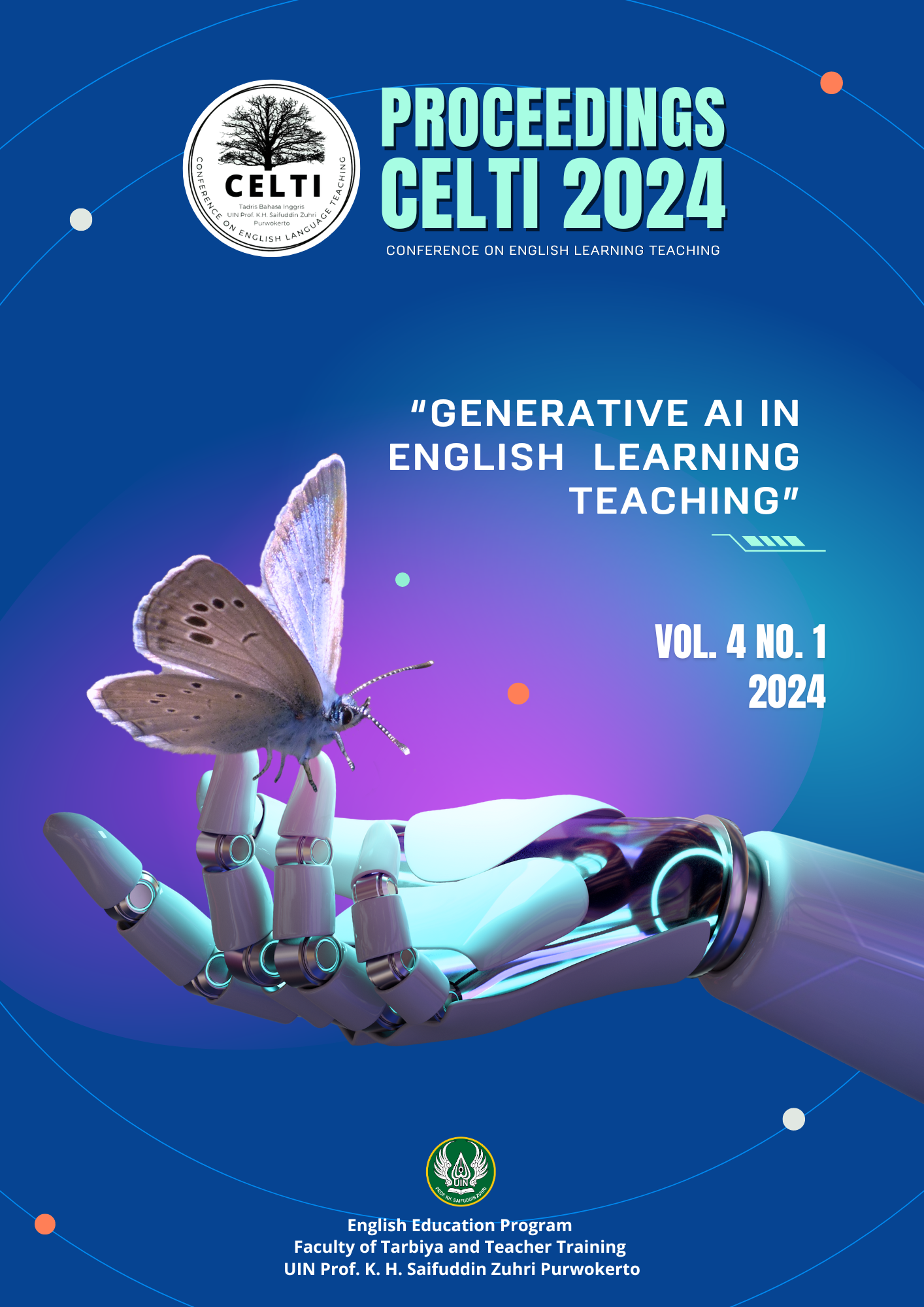Elsa Speak App: An Alternative Media to Improve EFL Students’ Speaking Skills in Indonesian Higher Education
Keywords:
EFL, Elsa Speak App, Learning English, Speaking, Online ApplicationAbstract
The present study aims to explore the implementation of the Elsa Speak application to improve the English learning process, especially in speaking ability. In addition, the study explores the perceptions of students in Indonesian higher education regarding the use of the Elsa application and the benefits of the application to convince students out there to be confident in using this application. In collecting data, the authors used qualitative and quantitative methods. Data were collected through semi-structured interviews and questionnaires. The findings revealed that students' English speaking skills have improved after using the Elsa application in the learning process. This can be seen from the interviews with participants and the final results of filling out the questionnaire. Therefore, the results of the study provide a contribution that the role of the Elsa Speak App is beneficial to increase the motivation of EFL students to learn speaking skills. The implication is discussed in this study.
References
Al-Jarrah, Tamer Mohammad, Jarrah Mohammad Al-Jarrah, Rania Hassan Talafhah, and Noraien Mansor. 2019. “The Role of Social Media in Development of English Language Writing Skill at School Level.” International Journal of Academic Research in Progressive Education and Development 8(1): 87–99.
Alizadeh, I. 2016. “Vocabulary Teaching Techniques: A Review of Common Practices.” ational Journal of Research in English Education 1(1): 22–30.
Arvanitis, Panagiotis, and Penelope Krystalli. 2021. “Mobile Assisted Language Learning (MALL): Trends from 2010 to 2020 Using Text Analysis Techniques.” European Journal of Education 4(1): 13–22.
Aswaty, Puja, and Ayu Indari. 2022. “The Effect of Using Elsa (English Language Speech Assistant) Speak Application on Students’ Speaking Ability for the Eleventh Grade of Mas Darul Al Muhajirin in the Academic Year 2021/2022.” Serunai : Jurnal Ilmiah Ilmu Pendidikan 8(1): 18–23.
Becker, & Edalatishams. 2019. “Figure 1 . The Skills-Based Start-up Page. Pronunciation in Second Language Learning and Teaching 10 434.” 2018(September 2018): 434–38.
Busetto, Loraine, Wolfgang Wick, and Christoph Gumbinger. 2020. “How to Use and Assess Qualitative Research Methods.” Neurological Research and Practice 2(1).
Dhivya, D. Sri, A. Hariharasudan, Wided Ragmoun, and Abdulaziz Abdulmohsen Alfalih. 2023. “ELSA as an Education 4.0 Tool for Learning Business English Communication.” Sustainability (Switzerland) 15(4).
Elhami, Ali, and Babak Khoshnevisan. 2022. “Conducting an Interview in Qualitative Research: The Modus Operandi.” Mextesol Journal 46(1): 0–2.
Francisco, Christopher et al. 2021. “The Use of Educational Applications on the Student’s Academic Performance.” Article in International Journal of Multidisciplinary Studies 5(February): 2643–9670. www.ijeais.org/ijamr.
Guo, Shiguang, and Qing Wang. 2022. “Application of Knowledge Distillation Based on Transfer Learning of ERNIE Model in Intelligent Dialogue Intention Recognition.” Sensors 22(3).
Haryati, H., & Dini, D. 2016. “SEKOLAH SEBAGAI SUMBER BELAJAR TERHADAP HASIL BELAJAR IPA PESERTA DIDIK KELAS IV SD INPRES BTN IKIP I MAKASSAR.” Jurnal Pendidikan Dasar Islam 3: 80–96.
Ismail, Ismail, Elihami Elihami, and Mustakim Mustakim. 2019. “Students’ Perceptions of the Benefits of Mobile Polling Technology in Teaching and Learning in College: Implications of Students’ Participation and Academic Performance.” Jurnal Pendidikan Progresif 9(1): 89–104.
Knott, Eleanor, Aliya Hamid Rao, Kate Summers, and Chana Teeger. 2022. “Interviews in the Social Sciences.” Nature Reviews Methods Primers 2(1).
Lee, Ju Seong, Kilryoung Lee, and Nur Arifah Drajati. 2019. “Preservice English Teachers’ Perceptions of English as an International Language in Indonesia and Korea.” Journal of Multilingual and Multicultural Development 40(3): 230–43. https://doi.org/10.1080/01434632.2018.1503669.
Levy, Mike. 2009. “Technologies in Use for Second Language Learning.” Modern Language Journal 93(SUPPL. 1): 769–82.
Maulina, Maulina, and Sari Yustika. 2022. “Harvest : An International Multidisciplinary and Multilingual Research Journal.” Harvest: An International Multidisciplinary and Multilingual Research Journal II(I): 55–63.
Pourhosein Gilakjani, Abbas, and Narjes Banou Sabouri. 2017. “Advantages of Using Computer in Teaching English Pronunciation.” International Journal of Research in English Education 2(3): 78–85.
Rahmi, Tysa Sufia, and S Neviyarni. 2022. “The Role of Learning Motivation (Extrinsic and Intrinsic) and Its Implications in the Learning Process.” International Journal of Educational Dynamics 5(1): 147–52. http://ijeds.ppj.unp.ac.id/index.php/IJEDS.
Rita, Yeni, and Ciptro Handrianto. 2021. “Innovation of Digital Learning in Package C Program in Facing the New Normal Education.” KOLOKIUM Jurnal Pendidikan Luar Sekolah 9(1): 20–29.
Samad, Ita Sarmita, and Ismail Ismail. 2020. “ELSA Speak Application as a Supporting Media in Enhancing Students’ Pronunciation Skill.” Majesty Journal 2(2): 1–7.
Suboh, Syahirah et al. 2023. “A Systematic Review of Anomaly Detection within High Dimensional and Multivariate Data.” International Journal on Informatics Visualization 7(1): 122–30.
T I Prasojo, A M Mufid, M R Fadliansyah, T Tawamu. 2021. “International Journal of Education , Information Technology and Others ( IJEIT ) The Usage of Group Chatting Platform for English Skills.” 4(1): 62–66.
Tambunsaribu, Gunawan, and Masda Surti Simatupang. 2021. “European Journal of Molecular & Clinical Medicine Pronunciation Problems Faced by Indonesian College Students Who Learn to Speak English.” European Journal of Molecular & Clinical Medicine 08(02): 759–66.
Teräs, Marko, Juha Suoranta, Hanna Teräs, and Mark Curcher. 2020. “Post-Covid-19 Education and Education Technology ‘Solutionism’: A Seller’s Market.” Postdigital Science and Education 2(3): 863–78.
Wahyuningsih, Sri. “THE USE OF VIDEO TO ENHANCE SPEAKING PROFICIENCY IN BROADCASTING : PERCEPTIONS OF UNDERGRADUATE.”
Wahyuningsih, Sri, and Muhamad Afandi. 2020. “Investigating English Speaking Problems: Implications for Speaking Curriculum Development in Indonesia.” European Journal of Educational Research 9(3): 967–77.
Wahyuningsih, Sri, and Siti Malaiha Dewi. 2019. “Promoting Speaking Proficiency in Broadcasting Through YouTube Project : Perceptions of Undergraduate Students.” : 1–7.
Xodabande, Ismail. 2017. “The Effectiveness of Social Media Network Telegram in Teaching English Language Pronunciation to Iranian EFL Learners.” Cogent Education 4(1). http://doi.org/10.1080/2331186X.2017.1347081.


